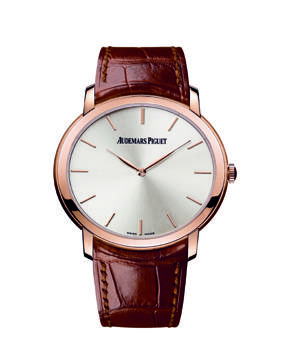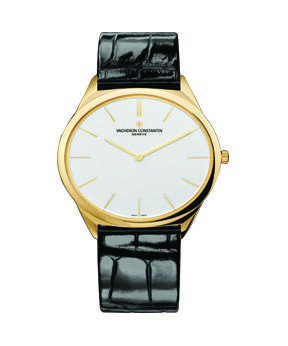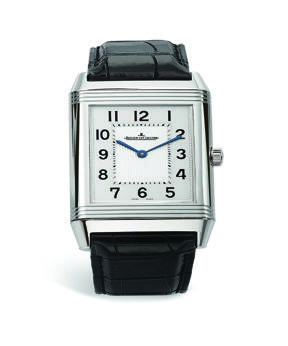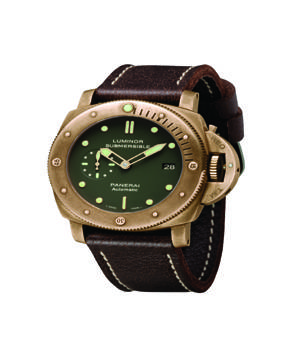What goes around, comes around –call them ultra thin or extra flat, thin dress watches are back, and a rose by any other name would be just as elegant. Though a newcomer to fine watchmaking in recent years might be forgiven for not knowing it, making a thin watch (and wearing one) was for decades considered an indispensable sign of sophistication. Only a top watchmaker could make a very thin watch, because a very thin watch needs a very thin mechanism inside, and during the golden age of the wristwatch –the period just after the end of World War II and, roughly, 1970 –the ultimate dress watch was gold, round and thin.
Making the mechanism (or movement) fit in a space with only a few millimeters’ headroom is no easy task. A thicker watch is easier to construct and maintain, and it’s a rule of thumb in watchmaking that the thicker the watch, the more accurate. A thin watch demands much higher precision in construction and more skill in assembly to run well –and achieving the elegant purity of design found in the best thin watches demands a discerning eye.
The earliest watches were thick, heavy objects, but by the mid-18th century, watchmaking had become advanced enough that thin movements could be made. By 1755, Pierre-Augustin Caron de Beaumarchais (today better remembered for the Figaro plays that are the basis of the world famous operas by Mozart and Rossini) had managed to eliminate or redesign many watch parts that require a thicker construction. His brother-in-law, Jean Antoine Lépine, further developed Beaumarchais’ ideas, and the extra thin movements that still follow his basic design are known as Lépine style movements to this day.
Today’s heirs to the tradition established by Beaumarchais and Lépine are a mixture of both old school traditionalists and new wave iconoclasts –sometimes both in the same company. Jaeger LeCoultre, for instance, is one of the best-known creators of thin movements, and such watches as their Master Ultra Thin contain mechanisms that would have been instantly recognizable to a watchmaker of Lépine’s day, but the firm is also a research powerhouse in cutting edge micromechanics. Piaget, another renowned leader in the creation of classic, ultra thin watches, has also continued to push the limits of movement design and in recent years has broken several long-standing records in thinness. Whether traditional, cutting edge or a mixture of both, today’s ultra thin watches all share the hard to define but instantly recognizable quality of elegance that’s let the thin dress watch stand the test of time.
AudemarsPiguet Jules Audemars Extra Thin Automatic
Rose gold, $21,800; white gold, $23,300
Though rightly famous for its Royal Oak and Royal Oak Offshore watches, AudemarsPiguet is also known to insiders as one of watchmaking’s greatest masters of complicated watchmaking. Though they may look simple, many experts rate true extra flat watches as complications in their own right, thanks to the difficulty in designing and assembling them. One of the most legendary extra flat movements in the world is behind the simplicity and purity of the Jules Audemars Extra Thin Automatic: the AudemarsPiguetcalibre 2120. One of the thinnest self-winding movements ever made, and still the thinnest full-diameter rotor automatic movement, the exquisitely finished skeletonized rotor rides on ruby rollers to help keep it functioning smoothly despite the extremely tight tolerances in its construction.
The VacheronConstantin “Les Historiques” 1955
$23,300
It’s only natural that the most venerable of watchmaking houses –VacheronConstantin has been in business since 1755 –is one of Switzerland’s greatest masters of ultra thin watchmaking as well. The “Les Historiques” 1955, based on a vintage model from that year, blends old school charm with carefully chosen, up to date technical advances. At only 1.64mm thick, the hand-wound movement inside (Vacheroncalibre 1003) is one of the thinnest ever made, and the entire watch is a mere 4.10mm. Such ultra thin watches are usually ultra fragile but clever engineering allows the use of a see through case, with a water resistance of up to 30 meters. Owners will appreciate this update to the original, solid case back design from 1955 –it allows a view of the stunning 18k gold movement.
The Jaeger LeCoultre Grande Reverso Ultra Thin
Rose gold $16,000; stainless steel $7,800
A classic since 1931, the Reverso’s rotating case was originally developed after an English polo player showed the cracked glass of his wristwatch to a Jaeger LeCoultre executive and asked for a watch that could protect itself. Though originally designed as a sports watch, the Reverso has come to be considered a classic dress watch as well, and an icon of Art Deco design. The reversible case is customizable with anything from an engraving to a one-of-a-kind miniature enamel painting, making the Reverso one of the most personal of treasures for the wrist as well. The newest addition to the Reverso family, the Grande Reverso Ultra Thin, is the first extra flat Reverso from Jaeger LeCoultre, in a contemporary size that still preserves the proportions of the 1931 model.



























